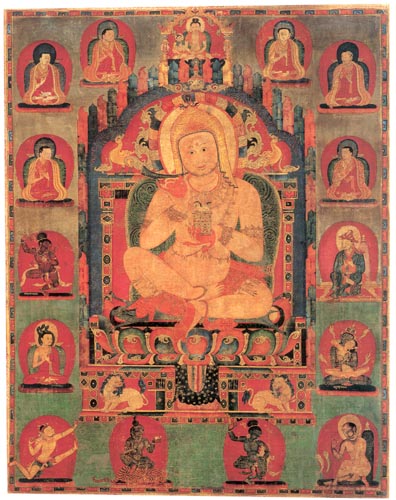| 33. Jnanatapa
|

33.
Jnanatapa
Eastern Tibet (Riwoche monastery), 14th century
Distemper on cloth
68.5 x 54.6 cm (27 x 211/2 in.)
The Metropolitan Museum of Art, New York; Purchase,
Friends of
Asian Art Gifts, 1987 (1987.144)
|
This painting of the Tantric practitioner Jnanatapa was created for Riwoche monastery in eastern Tibet during the
fourteenth century. Surrounding the central figure are the progenitors and abbots of Taklung monastery, of which
Riwoche was a branch (see illustration below). The two latest historical figures (nos. 6 and 7), identified by
inscription, are Onpo Lama Rinpoche (1251-1296), fourth abbot of Taklung and founder
of Riwoche, and his young
disciple, Choku Orgyan Gonpo (1293-1366), who became second abbot of Riwoche.1
About 1273, a schism arose within the Taklung community over the issue of who was to control the monastery. Historical accounts differ in their interpretation of these events, but it seems that Sangye Yarjon, the third abbot of Taklung, had promised the abbot's chair to two nephews, Onpo and Mangalaguru. When Sangye Yarjon died, Onpo, aged twenty-two, assumed the hierarch's position for one year. In 1273, his older cousin, Mangalaguru (1231-1297), took control of the monastery and Onpo fled to Kham, in eastern Tibet, where in 1276 he founded Riwoche.2
Despite some intriguing clues, the identity of the central figure in this painting was a mystery until recently. When the painting was uncovered in recent years, attached to it was a silk cloth inscribed with the name "Jnanatapa." The figure depicted under an arch, directly above the central figure and thus in the position where one
would expect his teacher to be, is identified by inscription as "Avagarbha." The identity of the central figure became clear after reference to a chapter on Onpo Lama Rinpoche in a Taklung history written by Ngawang Namgyal (1571-1626). Onpo's biography includes a tale about one of his previous lives in India. Ngawang Namgyal states that in his Indian incarnation, Onpo was "the peerless
mahasiddha Jnanatapa," and his Tantric teacher was Avagarbha, a Bengali siddha in the tradition of Tilopa and
Naropa.3 Remarkably, here we have a painting that illustrates the spiritual lineage of Riwoche monastery, featuring at its center a portrait of one of the
Indian incarnations of its founder. Why Onpo's Indian incarnation should have been considered a worthy
subject for portraiture is unclear, but one recalls the Tibetan concern for the purity of its spiritual lineages,
which were often judged by their unbroken links with respected Indian masters.4
Another factor might also have influenced this choice of iconography. Medieval Mahayana Sanskrit texts,
notably Shantideva's Bodhicharyavatara, the Avalokana Sutra, and the
Bhaisajyaguru Sutra, all translated into
Tibetan, emphasize the importance of jatismara, the recollection of one's former lives. In discussing this
practice, the Indian historian Gregory Schopen notes that by remembering
former lives, a Buddhist is able to garner
more quickly the lessons of his past and avoid negative rebirth.5 There is a long tradition within Buddhist art of representing the former lives of the historical Buddha
(known as Jataka tales). This portrait may point to a parallel tradition within Tibetan art, in which the previous
lives of respected hierarchs became a theme, an intriguing aspect of Tibetans' biographies of their revered saints.6
The style of this painting is startlingly different from that associated with Taklung in central Tibet. The mountain staves, a motif frequently seen in paintings from Taklung and other sites in central Tibet, are used here with greater restraint, merely suggesting a mountain cave setting for Jnanatapa. The Riwoche artist places Jnanatapa and the other portraits against a relatively empty background, a feature seen in none of the
paintings associated with the Taklung center. A second notable difference in this style is the emphasis on shading to suggest three-dimensional form, seen especially in the depictions of its mahasiddhas, a technique not typical of earlier painting from central Tibet. It is likely that eastern Tibet had its own local painting traditions, adopted by the successors of Onpo Lama Rinpoche at Riwoche. JCS
1. Ngawang Namgyal 1972, P. 904 ff.
See also Kossak 1990 and
Singer 1997, pp. 65-67. [back]
2. Roerich 1979, pp. 631, 650-52. [back]
3. Ngawang Namgyal 1972, p. 872. 1 am grateful to Gyurme
Dorje for bringing this passage to my attention. [back]
4. Jnanatapa also appears in an earlier Onpo portrait painting,
published in Singer and Denwood 1997, pl. 41. In a side register to the proper right of the central figure, Jnanatapa
wears his distinctive helmet, carrying a small horn and holding a
casket surmounted by a lion. [back]
5. Schopen 1993. [back]
6. The Tibetan historian Go Lotsawa mentions other Tibetans of
this period who are said to have remembered their former lives; for instance, Rinchen Sengge (d. 1337). See Roerich
1979, p. 282, and passim. [back]
|
